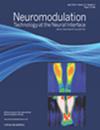个性化θ经颅交变电流刺激和γ经颅交变电流刺激对静息脑电图产生不同的神经调节作用:描述经颅交变电流刺激的时间、空间和频谱维度。
IF 3.2
3区 医学
Q2 CLINICAL NEUROLOGY
引用次数: 0
摘要
目的:经颅交变电流刺激(tACS)对脑电图(EEG)动态的神经调节作用存在很大差异。本研究的主要目的是全面描述两种经颅交变电流刺激方案对静息状态脑电图的影响:共招募了 36 名健康参与者,随机分为三组。两组在额叶区域双侧接受个性化的θ(4-8 Hz)或γ(40 Hz)刺激,持续 20 分钟(ON 4 分钟,OFF 1 分钟,四个周期)。第三组进行 20 分钟的放松呼吸观察。从基线、tACS 期间和刺激后的静息脑电图中提取无伪影的 1 分钟脑电图片段,以观察 tACS 的影响。统计推论采用了无阈值聚类增强置换检验(用于频谱测量)和双向混合方差分析(用于非周期性斜率):结果:使用 ROAST 和预设参数(800 μA、AF3 AF4 位置)进行的电流建模模拟显示,诱导电场可激活额叶皮层区域。在刺激期间,个性化的θ tACS会抑制顶中央区的θ波段功率。在θ tACS之后,β和γ波段的功率出现了补偿性下降。在刺激过程中,γ tACS 没有观察到诱导效应,但在刺激后,顶枕区的θ和β波段观察到了显著的诱导效应。中央区域的 delta 波段功率下降。呼吸观察后未发现频谱调制。测量非周期性活动的频谱斜率没有受到屏气或 tACS 的影响:结论:确定多种 tACS 方案的效果对于有效针对特定神经振荡模式和个性化方案至关重要。这项研究可扩展到针对与神经精神疾病认知障碍相关的特定振荡模式。本文章由计算机程序翻译,如有差异,请以英文原文为准。
Personalized Theta Transcranial Alternating Current Stimulation and Gamma Transcranial Alternating Current Stimulation Bring Differential Neuromodulatory Effects on the Resting Electroencephalogram: Characterizing the Temporal, Spatial, and Spectral Dimensions of Transcranial Alternating Current Stimulation
Objectives
The neuromodulatory effects of transcranial alternating current stimulation (tACS) on electroencephalogram (EEG) dynamics are quite heterogenous. The primary objective of the study is to comprehensively characterize the effects of two tACS protocols on resting-state EEG.
Materials and Methods
A total of 36 healthy participants were recruited and were randomized into three groups. Two groups received either personalized theta (4–8 Hz) or gamma (40 Hz) stimulation bilaterally in the frontal regions for 20 minutes (4 minutes ON, 1 minute OFF, four cycles). The third group performed relaxed breath watching for 20 minutes. Artifact-free, 1-minute EEG segments from the baseline, during tACS, and after stimulation resting EEG were characterized to see the effects of tACS. Threshold-free cluster enhanced permutation tests (for spectral measures) and two-way mixed analysis of variance (for aperiodic slope) were used for statistical inferences.
Results
Current modeling simulation using ROAST with preset parameters (800 μA, AF3 AF4 locations) showed that induced electric fields can activate frontal cortical regions. During the stimulation period, personalized theta tACS entrained theta band power in the centro-parietal areas. There was a compensatory power decrease in the beta and gamma bands after theta tACS. No entrainment effects were observed for gamma tACS during stimulation, but a significant entrainment was observed in the theta and beta bands in the parieto-occipital regions after stimulation. The delta band power decreased in the central regions. No spectral modulations were seen after breath watching. The spectral slope, which measures aperiodic activity, was not affected by either breath watching or tACS.
Conclusions
Characterizing the effects of multiple tACS protocols is critical to effectively target specific neural oscillatory patterns and to personalize the protocols. The study can be extended to target specific oscillatory patterns associated with cognitive deficits in neuro-psychiatric conditions.
求助全文
通过发布文献求助,成功后即可免费获取论文全文。
去求助
来源期刊

Neuromodulation
医学-临床神经学
CiteScore
6.40
自引率
3.60%
发文量
978
审稿时长
54 days
期刊介绍:
Neuromodulation: Technology at the Neural Interface is the preeminent journal in the area of neuromodulation, providing our readership with the state of the art clinical, translational, and basic science research in the field. For clinicians, engineers, scientists and members of the biotechnology industry alike, Neuromodulation provides timely and rigorously peer-reviewed articles on the technology, science, and clinical application of devices that interface with the nervous system to treat disease and improve function.
 求助内容:
求助内容: 应助结果提醒方式:
应助结果提醒方式:


